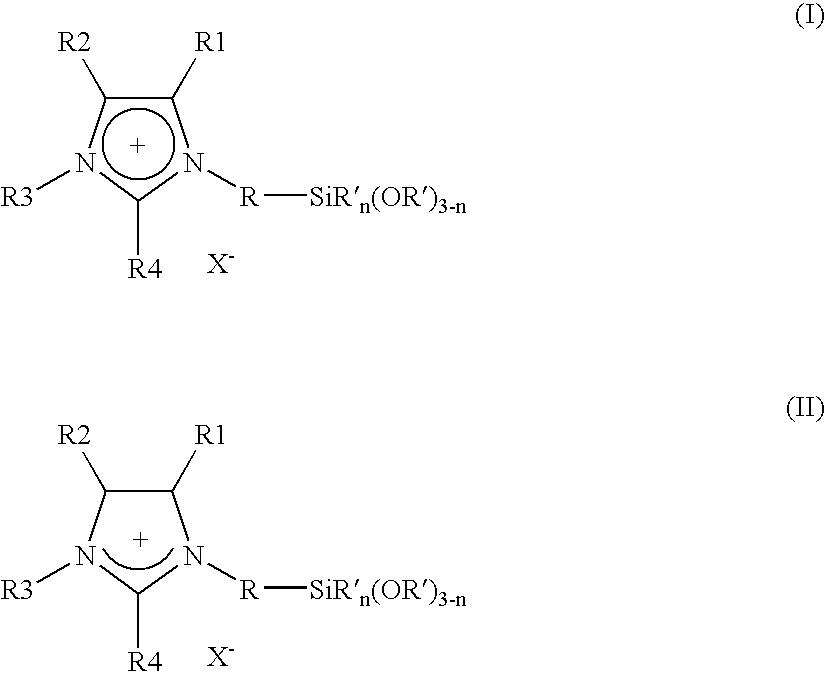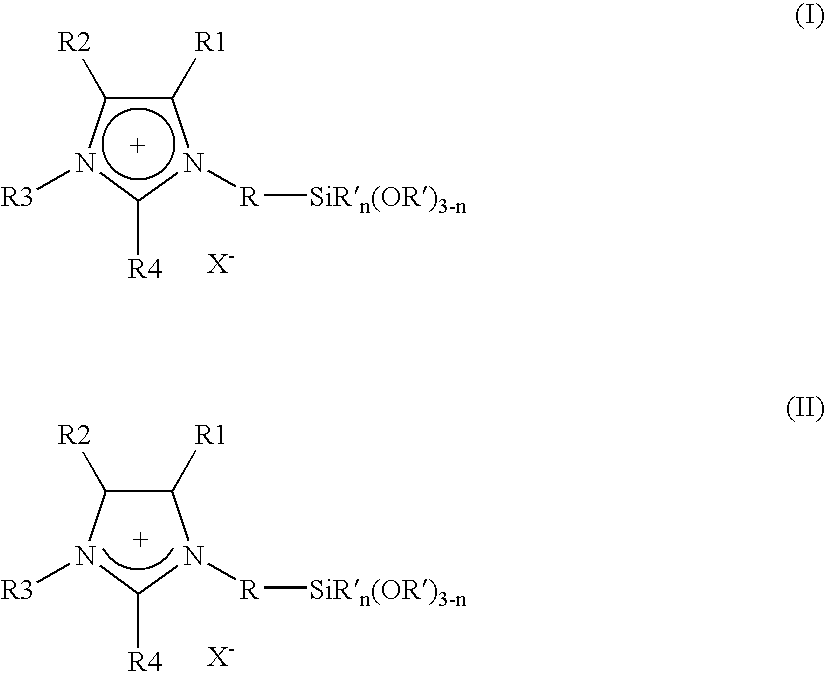Imidazolium salts that can be immobilized
a technology of imidazolium salts and immobilized salts, which is applied in the field of new immobilized imidazolium salts, can solve the problems of inability to immobilize covalently on inorganic oxides, inability to use compounds of type c and d, and inability to achieve thermal stability at room temperature, and achieves simple and inexpensive process , facilitates simple separation of transition metal catalysts, and high thermal stability
- Summary
- Abstract
- Description
- Claims
- Application Information
AI Technical Summary
Benefits of technology
Problems solved by technology
Method used
Image
Examples
example 1
Synthesis of 1-mesityl-3-[3-(triethoxysilyl)propyl]imidazolium Chloride
[0177] 18.63 g (0.1 mol) of 1-mesitylimidazole and 26.49. g (0.11 mol) of 3-chloropropyltriethoxysilane are introduced under an argon atmosphere into a flask fitted with reflux condenser. The mixture is refluxed at 90° C. for 5 days. The volatile constituents are removed under reduced pressure. The mixture is washed with petroleum ether until the washings remain colourless. Drying under reduced pressure gives the product as a pale-brown solid.
[0178] Melting point: 135° C. C21H35ClN2O3Si (426.21 g / mol). Analysis [%]: calculated: C 59.2, H 8.3, N 6.6; found: C 58.5,. H 7.7, N 6.8. 1H-NMR (d8-Thf):δ 0.64-0.72 (m, 2H, SiCH2), 1.16 (t, 3I=7.0Hz, 9H, CH2CH3), 2.01-2.23 (m, 2H, NCH2CH2), 2.13 (s, 6H, o-C6H2Me2), 2.34 (s, 3H, p-C6H2Me), 3.82 (q, 3I=7.0 Hz, 6H, OCH2), 4.74 (t, 3I=7.0 Hz, 2H, NCH2), 7.05 (s, 2H, C6H2Me3), 7.66-7.70 (m, 1H, NCHCHN), 8.41-8.45 (m, 1H, NCHCHN), 11.68-11.75 (m, 1H, NCHN). 13C-NMR(d8-Thf): δ ...
example 2
Synthesis of 1-mesityl-3-[3-(triethoxysilyl)propyl]imidazolium triflate (Anion Exchange)
[0179] 500 mg (1.17 mmol) of 1-mesityl-3-[3-(triethoxysilyl)propyl]imidazolium chloride and 243 mg (1.29 mmol) of potassium trifluoromethanesulfonate are dissolved in 30 ml of CH2Cl2 under an argon atmosphere in a flask and stirred at 25° C. for 2 hours. The resultant precipitate is separated off from the solution by filtration. The volatile constituents of the solution are removed under reduced pressure. The residue is washed a number of times with heptane and dried under reduced pressure, giving the product as a pale-brown solid.
[0180] Melting point 87° C. C22H35F3N2O6SSi (540.19 g / mol). Analysis [%]: calculated: C 48.9, H 6.5, N 5.2; found: C 48.7, H 6.4, N 5.3. 1H-NMR (d8-Thf):δ 0.62-0.71 (m, 2H, SiCH2), 1.19 (t, 3I=7.0 Hz, 9H, CH2CH3), 2.00-2.23 (m, 2H, NCH2CH2), 2.09 (s, 6H, o-C6H2Me2), 2.35 (s, 3H, p-C6H2Me), 3.82 (q, 3I=7.0 Hz, 6H, OCH2), 4.49 (t, 3I=7.2 Hz, 2H, NCH2), 7.08 (s, 2H, C6H2...
example 3
Synthesis of 1-mesityl-3-[4-(trimethoxysilyl)benzyl]imidazolium Chloride
[0181] 10.00 g (54 mmol) of 1-mesitylimidazole and 14.66 g (59 mmol) of (p-chloromethyl)phenyltrimethoxysilane are introduced under an argon atmosphere into a nitrogen flask and boiled overnight at 80° C. A dark-brown solution is formed, which becomes a solid after about 30 minutes. This is dissolved in CH2CI2, and the solution is evaporated under reduced pressure until a dark-brown, viscous substance remains. This is washed a number of times with heptane and dried under reduced pressure, giving the product as a pale-brown powder.
[0182] Melting point: 170° C. C22H29ClN2O3Si (433.03 g / mol). Analysis [%] calculated: C 61.0, H 6.8, N 6.5, found: C 58.7, H 7.1, N 5.8. 1H-NMR (CDCl3): δ 1.96 (s, 6H, o-C6H2Me2), 2.24 (s, 3H, p-C6H2Me), 3.54 (s, 9H, OMe3), 5.90 (s, 2H, CH2), 6.89 (s, 2H, C6H2Me3) 7.10 (m, 1H, NCHCHN), 7.54 (d, I3=0.03 Hz, 2H, C6H4), 7.60 (d, I3=0.03 Hz, 2H, C6H4), 7.69 (m, 1H, NCHCHN), 10.82 (s, 1H, ...
PUM
| Property | Measurement | Unit |
|---|---|---|
| temperature | aaaaa | aaaaa |
| temperature | aaaaa | aaaaa |
| temperature | aaaaa | aaaaa |
Abstract
Description
Claims
Application Information
 Login to View More
Login to View More - Generate Ideas
- Intellectual Property
- Life Sciences
- Materials
- Tech Scout
- Unparalleled Data Quality
- Higher Quality Content
- 60% Fewer Hallucinations
Browse by: Latest US Patents, China's latest patents, Technical Efficacy Thesaurus, Application Domain, Technology Topic, Popular Technical Reports.
© 2025 PatSnap. All rights reserved.Legal|Privacy policy|Modern Slavery Act Transparency Statement|Sitemap|About US| Contact US: help@patsnap.com



